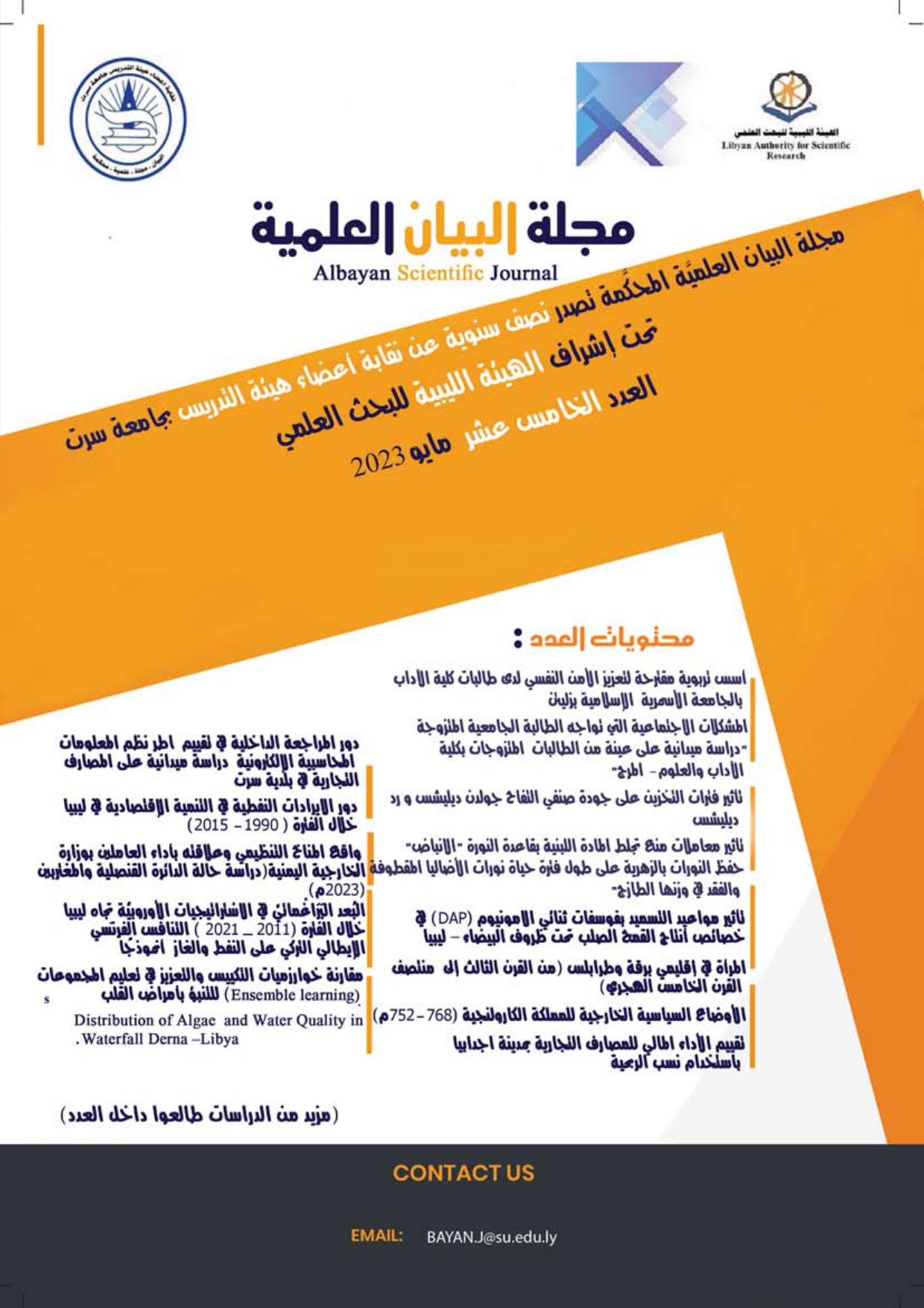تأثير مواعيد التسميد بفوسفات ثنائي الامونيوم (DAP) في خصائص أنتاج القمح الصلب تحت ظروف البيضاء – ليبيا
Keywords:
diammonium phosphate time of durum fertilizationAbstract
Two field experients were conducted EL- Mokhtaar university at EL—Bayda during the growing seasons 2015- 16 and 2016- 17 to
Study the response of durum wheat (Marjawii) cultivar to fertilization time at seeding , at tillering stage comparing to control. Seeding by drilling in the rate 110 kg ha -1 and fertilization by hand by the rate 250kg ha-1 . The experiments layed out in RCBD design by 4 replicates each having 3units with an area 4× 1.5 (6m)2
Results revealed significant different (P<0.01 ) in number and weight of spike grains due to during seeding time significant increase (p< 0.05 ) of 1000- grain weight in 2 nd season only and no affect of harvest index in both seasons by time of fertilization , significant increase (p< 0.01 ) of biological yield 4.53 , 4.68 and Straw yield 3.61 , 3.75 t ha -1 due to at seeding time .
Although grain yield recorded 0.92 , 0.93 t ha -1during seeding time mean while not neach significant level . Dunning tillering time gave the significant increase of protein content 12.81 , 12.85 % in both seasons res pectiuey : In conclusion the best date for addition DAP fertilizer for durum wheat in albayda during seeding datee.
References
المراجع:
Khan, G. A., & Sajid, M. (2007). Response of dhalia (Dhalia pinnata) to different levels of nitrogen alone and in combination with constant doses of phosphorus and potassium. American-Eurasian Journal of Sustainable Agriculture, 25-32.
Lei.L;W.Jiao and Y.C.Yan (2008) . Evaluating nitrogen management of farm systems in the steep- mountainaous KARST region. American-Eurasian.J of sustain able Agniculture, 2(2): 180-186
Mainard,D, S.& Jeuffroy, M. H. (2001). Partitioning of dry matter and nitrogen to the spike throughout the spike growth period in wheat crops subjected to nitrogen deficiency. Field Crops Research, 70(2), 153-165.
Modhej(2006). Effect of heat stress affer an Thesis on grain yield of wheat and barky genotypes Conf of German Genetics soc and German soc of plant breeding 95.
Modhej& Behdarvandi(2006). Effect of heat stress after anthesis on source limitation of wheat and barley genotypes . 24Th annual meeting of ESCB. Belgium, 28.
Peltonen-Sainio, P., Kangas, A., Salo, Y., & Jauhiainen, L. (2007). Grain number dominates grain weight in temperate cereal yield determination: evidence based on 30 years of multi-location trials. Field Crops Research, 100(2-3), 179-188.
Rane, J., & Nagarajan, S. (2004). High temperature index—for field evaluation of heat tolerance in wheat varieties. Agricultural Systems, 79(2), 243-255
Satorre, E. H., & Slafer, G. A. (2000). Wheat: ecology and physiology of yield determination. published by food product press. 503.
Shao,H. B.,L.Y.Chu.,G.Wu.,J.H. Zhang.,Z.H.Lu., Y.C. Hu.(2007) . Changes of some anti-oxidative physiological indices under soil water deficit Surface B:Biointerfaces 54(2):143-149.
Stone, P. J., Savin, R., Wardlaw, I. F., & Nicolas, M. E. (1995). The influence of recovery temperature on the effects of a brief heat shock on wheat. I. Grain growth. Functional Plant Biology, 22(6), 945-954.
Wardlaw, I. F., & Moncur, L. J. F. P. B. (1995). The response of wheat to high temperature following anthesis. I. The rate and duration of kernel filling. Functional Plant Biology, 22(3), 391-397
Wardlaw, I. F., Sofield, I., & Cartwright, P. M. (1980). Factors limiting the rate of dry matter accumulation in the grain of wheat grown at high temperature. Functional Plant Biology, 7(4), 387-400.
Zadoks, J.C., T.T. Chang, and C.F. Konzak, A decimal code for the growth stages of cereals. Weed research, 1974. 14(6): p. 415-421













